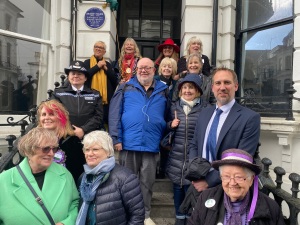(This item first appeared in the Brighton Argus on 27th March 2024)
When I was a councillor in the 1980s, I used to love door-knocking, both during election campaigns and throughout the year. But there was one exception, a street I never enjoyed visiting: St Michael’s Place in central Brighton. It was inevitably windy and raining. I was back in St Michael’s Place last Saturday. Not only was there a bitterly cold west wind, and not only did it rain, there was a most dramatic hailstorm the likes of which I have seldom experienced in England.
 But Saturday was different. It was an uplifting and joyful celebration of the life of Mary Hare, a suffragette, the founder of an independent women’s police force in Brighton and, most importantly, a pioneering teacher of deaf children. The Mayor, Cllr. Jackie O’Quinn was there, the Brighton and Hove Bus that bears the name ‘Mary Hare’ was incongruously parked in this side street, and at least half those present were communicating through sign language. They were all there to witness the unveiling of a blue plaque to commemorate the life and work of Mary Hare.
But Saturday was different. It was an uplifting and joyful celebration of the life of Mary Hare, a suffragette, the founder of an independent women’s police force in Brighton and, most importantly, a pioneering teacher of deaf children. The Mayor, Cllr. Jackie O’Quinn was there, the Brighton and Hove Bus that bears the name ‘Mary Hare’ was incongruously parked in this side street, and at least half those present were communicating through sign language. They were all there to witness the unveiling of a blue plaque to commemorate the life and work of Mary Hare.
17 St Michael’s Place was Mary’s home from 1895 to 1901, and was one of the sites of the school she had founded. According to the programme prepared for the unveiling, “Mary was ahead of her time in championing the rights and wellbeing of deaf children and women” and was “a revolutionary campaigner for the inclusion in society and education of deaf children who, at that time, were often abandoned in asylums, or considered by some as unworthy of education.”
Mary was a committed suffragette and a contemporary of Mary Clarke, the sister of Emmeline Pankhurst, Brighton resident and organiser, and the first suffragette to die for women’s right to vote. There is currently a campaign to have a statue of Mary Clarke erected in the gardens of the Royal Pavilion to commemorate her life and work.
The Brighton Gazette of 1908 reports that Mary Hare chaired a Women’s Social and Political Union meeting on Queen’s Road where she said that suffragettes “were going to rouse Brighton”. In 1913 she became secretary of the Brighton Women’s Freedom League, which was prepared to break the law, but rejected violence.
In 1915 Mary Hare set up a volunteer uniformed women’s police force, much against the wishes of the local constabulary, to assist Brighton and Hove’s women and children. An article in the Brighton, Hove and South Sussex Graphic entitled ‘Bobby – the Woman Policeman’ records her work and describes Mary as looking “particularly smart in her uniform and bowler hat”. Times have moved on and one of the speakers at the unveiling of the blue plaque in St Michael’s Place was Superintendent Petra Lazar from Sussex Police.
Her true passion, however, was as an educationalist for deaf children. She said that her efforts on behalf of these children “have been my greatest joy in life.” She established, originally in London, the Private Oral School for Deaf Children in 1895, taking mixed pupils of all ages from across the country. In 1916 the school moved to larger premises in Sussex, and then to Berkshire, where the Mary Hare Grammar School for the Deaf still operates.
A past student of the Mary Hare Grammar School is Brighton-born Margaret Stewart who lives with her husband John in Patcham. Margaret single-handedly set about fundraising for the blue plaque to recognise the pioneering work of the remarkable Mary Hare. ‘Remarkable’ can also be said of the formidable Margaret Stewart who herself should be seen as an inspiration to us all. She might be small in stature but she has displayed a steely determination to honour Mary Hare.
While Margaret was the driving force behind securing the blue plaque for Mary Hare, others have supported her including the influential Brighton Women’s History Group. Present, too, at the unveiling was the current Head of the Mary Hare School for the Deaf in Berkshire, Robin Askew, and the force of nature that is Victoria Garcia from Brighton and Hove Buses who does so much to ensure that the names of more of the daughters of the city are celebrated on our buses.
About the independent police force, Mary Hare said that “we are out to do good work in Brighton, and we have had unsolicited testimonials to the effect that we have done good.” This could be said about all of her life’s work. It can also be said of Margaret Stewart, and those words should be a challenge to the rest of us “to do good in Brighton.”

